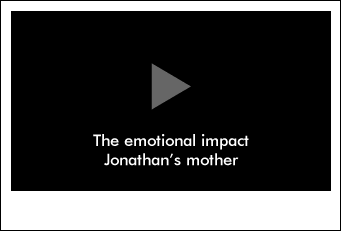- SELF STUDY MODULES
- 1. Intro to TBI
- 2. Communication
- 3. Skills for independence
- 4. Cognitive changes
- 5. Behaviour changes
- 6. Sexuality
- 7. Case management (BIR)
- 8. No longer available
- 9. Mobility & motor control
- 10. Mental health & TBI:
an introduction - 11. Mental health problems
and TBI: diagnosis
& management - 12. Working with Families
after Traumatic Injury:
An Introduction - 13. Goal setting
- 12.0 Aims
- 12.0A Take the PRE-Test
- 12.1 Why is working with families important
- 12.2 What is the adjustment experience for families
- a) The journey
- b) The challenges
- 12.3 Principles and skills
- a) Partnering
- b) Whole of family
- c) Family reactions
- d) Respect
- e) Empowering
- 12.4 When to get help
- 12.5 Take home messages
- 12.6 Resources
- 12.7 Take the POST-Test
12.1 Why is working with families important
- i) Families Q
- ii) Defining
families - iii) Why is working
with families important - iv) Three
families : Videos
i) Families
There are many types of family.
Think about who they live with.
In the list below are just some types of family situations, tick all the family types that are familiar to you.
There are many types of family.
Families may include nuclear, step, or blended, and same sex arrangements.
Family members may be children, parents, single parents, siblings, aunts, uncles, cousins, grandparents, foster parents, adoptive parents, step parents, and couples without children spanning two, three or even four generations.
A wide range of ages can be represented.
ii) What is a Family?
Families can be defined as those people who are:
- family related by birth
- the family gained through marriage or agreement
- family of choice and friends (not related biologically or by marriage)
1 Definition adapted from Canadian Palliative Care Association, Standards for Palliative Care Provision, June 1998
There are many families.

iii) Why is working with families important?
- People don’t live in isolation
- Everyone has experience of family
- Culture and religion influence families
- Working with families leads to better outcomes for the injured person
- Families are often a great resource
- Most people with traumatic injury are discharged home and into the care of family who provide the majority of support to the injured person

iv) Hearing from three families
In this module you will hear from three different families about their experiences. Here is an introduction to each families. Each of the three introductory videos is about a minute in length.
Angela (1 min 24 sec)
Angela is the mother of Steven. When Steven was 16 years old he was involved in a motor vehicle accident and sustained a traumatic brain injury.
Steven was acutely managed at Westmead Hospital and then spent 6 months in the Westmead Brain Injury Rehabilitation Unit.
Angela and her husband have 4 children. Steven has an older brother and two younger sisters. At the time of the videos Steven was 10 years post-injury, and Angela reflects on her experience of the rehabilitation experience, preparing to come home and being at home.
The video may take a few moments to load.
Cheryl (1 min)
Cheryl is the wife of Peter. She was interviewed in August 2009 in Sydney Australia. Cheryl and Peter have two adult children. Their daughter was aged 18 and their son was 23 at the time of Peter’s Spinal Cord Injury.
Peter sustained an incomplete C5 Quadriplegic level injury in November of 2006 as the result of a spinal abscess. Peter’s injury was initially managed in the acute Spinal Injury Unit at Royal North Shore Hospital. After approximately 2 months, Peter was transferred to the Moorong Spinal Unit at the Royal Rehabilitation Centre Sydney for ongoing treatment.
At the time of Peter’s injury both he and Cheryl worked. Peter was a university lecturer and Cheryl a primary school teacher. At the time of this DVD recording Peter was 2.5 years post-injury, and Cheryl reflects on her experience of the rehabilitation ward, preparing to come home and being at home.
The video may take a few moments to load.Jonathan's mother(1 min)
Jonathan was hit by a car when he was 12 years old. He had a severe traumatic brain injury.
At the time of the injury he had a very poor prognosis -unlikely to regain any previous function. He had extensive rehabilitation. He is now in his mid 20's living with his family. He is learning to drive and has several part time jobs. He has a brother.
Jonathan's mother is also called Cheryl. In this module she is referred to as "Jonathan's mother" so as to ensure there is no confusion between the two Cheryls. She has written the book Paper Cranes: A mother's Story of Hope, Courage and Determination.
The video may take a few moments to load.



